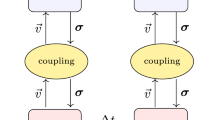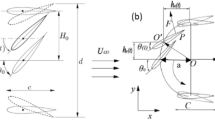Abstract
A mathematical model is proposed for calculating the forces and moments acting on an aircraft in the region affected by the wake vortex generated by another aircraft. This model takes into account various random factors and determines the wake vortex characteristics, as well as its shape, which depends on integral and distributed characteristics of atmospheric turbulence. The computational scheme, which involves the use of artificial neural networks, allows real-time calculation of the aerodynamic characteristics of the aircraft and to ensure training of pilots on flight simulators.
Similar content being viewed by others
References
A. M. Gaifullin, Vortex Flows (Nauka, Moscow, 2015) [in Russian].
A. M. Gaifullin and Yu. N. Sviridenko, “Mathematical Model of the Aircraft Aerodynamics in a Vortex Wake,” Uch. Zap. TsAGI 41(4), 3–16 (2010) [TsAGI Sci. J. 41 (4), 365–384 (2010)].
S. C. Crow, “Stability Theory for a Pair of Trailing Vortices,” AIAA J. 8(12), 2172–2179 (1970).
S. C. Crow and E. R. Bate, Jr., “Lifespan of Trailing Vortices in a Turbulent Atmosphere,” J. Aircraft 13(7), 476–482 (1976).
A. M. Gaifullin, “Equations for Perturbations Growing in the Wake behind an Aircraft,” Izv. Ross. Akad. Nauk, Mekh. Zhidk. Gaza, No. 3, 122–132 (2001).
V. V. Vyshinskii and G. G. Soudakov, “Wake Vortex Generated by an Aircraft in the Turbulent Atmosphere,” Tr. TsAGI, No. 2667 (2005).
T. Gerz, F. Holzäpfel, and D. Darracq, “Commercial Aircraft Wake Vortices,” Progr. Aerospace Sci., No. 3, 181–208 (2002).
S. Shen, F. Ding, J. Han, et al., “Numerical Modeling Studies of Wake Vortices: Real Case Simulation,” AIAA Paper No. 0755 (1999).
V. P. Kuzmin, “Estimation of Wake-Vortex Separation Distances for Approaching Aircraft,” Tr. TsAGI, No. 2627, 209–224 (1997).
V. Frost and T. Moulden, Handbook of Turbulence. Fundamentals and Application (Plenum, New York, 1977).
Yu. N. Sviridenko and Yu. L. Ineshin, “Application of the Panel Method with Symmetrization of Singularities to Calculating the Flow around the Aircraft with Allowance for the Influence of Engine Jets,” Tr. TsAGI, No. 2622, 41–53 (1996).
Author information
Authors and Affiliations
Corresponding authors
Additional information
Original Russian Text © A.M. Gaifullin, O.V. Animitsa, I.S. Bosnyakov, P.V. Kuzmin, Yu.N. Sviridenko, S.N. Suprunenko, K.G. Khairullin.
Translated from Prikladnaya Mekhanika i Tekhnicheskaya Fizika, Vol. 60, No. 2, pp. 148–157, March–April, 2019.
Rights and permissions
About this article
Cite this article
Gaifullin, A.M., Animitsa, O.V., Bosnyakov, I.S. et al. Modeling of Aircraft Flight Through the Wake Vortex. J Appl Mech Tech Phy 60, 314–322 (2019). https://doi.org/10.1134/S0021894419020123
Received:
Revised:
Accepted:
Published:
Issue Date:
DOI: https://doi.org/10.1134/S0021894419020123




